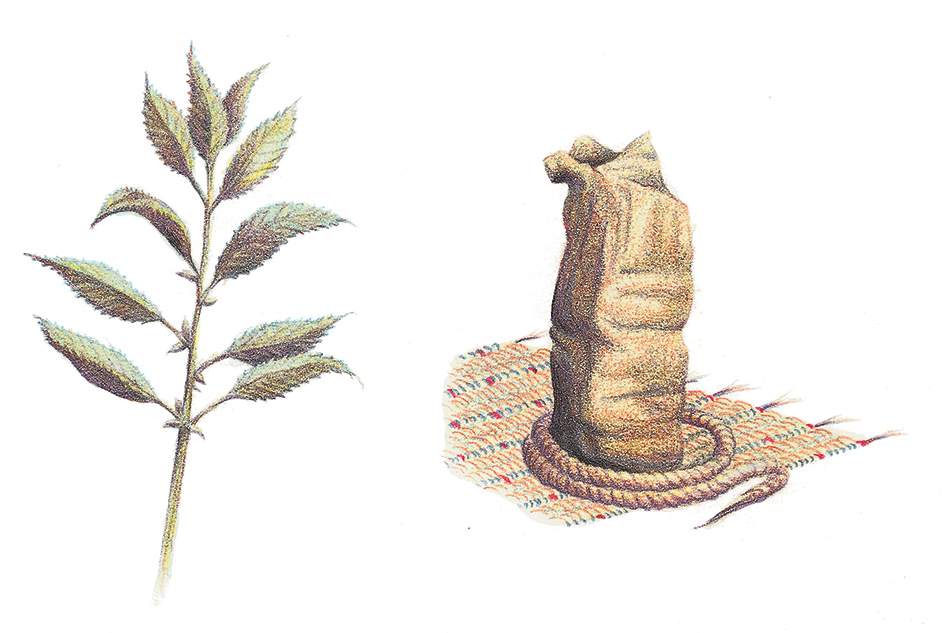Materials are types of matter in solid form from which people can make objects. They belong to two groups: natural materials and extracted materials. Natural materials, which include stone, wood, and wool, are used much as they occur in nature. Extracted materials, such as plastics, alloys (metal mixtures), and ceramics, are created by processing various natural substances.
Manufacturers determine which material to use for a given product by evaluating the properties (qualities) of materials. For example, stainless steel, an alloy of steel and chromium, resists heat and corrosion (rust and other chemical damage). It thus makes a good material for saucepans, prosthetic (artificial) body parts, and parts for missiles.
Some properties can be linked with a material’s macrostructure (structure visible to the unaided eye). For example, the long, parallel fibers of wood give wood relatively strong resistance to a force applied in the same direction as the grain (direction of the fibers), but relatively weak resistance to a force applied at a right angle to the grain. Other properties are explained by a material’s microstructure (structure that can be seen only through a microscope). The low density of wood, for example, is due to the open structure of its microscopic cells. At the most basic level, the properties of materials are determined by chemical bonds, forces that attract atoms to one another and hold them together.
Materials scientists study how the structure of materials relates to their properties. A large part of the scientists’ work involves experimentation. For example, they alter the microstructure of a material, then determine how these changes affect the properties. Materials engineers, who work in much the same way, develop new materials for use in commercial products.
Materials scientists and engineers have developed a wide variety of engineered materials. These materials include strong but lightweight composite materials made up of reinforcing materials embedded in a continuous solid body called a matrix. For example, carbon fibers in a matrix of adhesive resin are used to make tennis rackets and parts for aircraft. Embedding sensors and actuators (devices that produce movement in response to a signal) in composite materials results in sophisticated smart materials. These materials can alter their shape or operation in response to changes in conditions in their environment.
Properties of materials
Scientists group the properties of materials according to various functions that must be performed by objects made of the materials. For example, mechanical properties are critical in a material for a part that must resist strong mechanical forces, such as a beam of a bridge. Most properties of materials fall into six groups: (1) mechanical, (2) chemical, (3) electrical, (4) magnetic, (5) thermal, and (6) optical.
Mechanical properties
are critical in a wide variety of structures and objects, from houses and space vehicles to chairs and toothbrushes. Some of the most important mechanical properties are (1) stiffness, (2) yield stress, (3) toughness, (4) strength, (5) creep, and (6) fatigue resistance.
Stiffness
measures how much a material deflects (stretches) when subjected to a mechanical force. For example, the amount of stretch of an elastic band or the deflection (bend) of a shelf when a heavy book is placed on it both depend on the material’s stiffness.
Yield stress
measures how much force per unit area (per square inch or square centimeter, for example) must be exerted on a material for it to permanently deform (change its shape). Materials that deform easily—that is, those that have a low yield stress—are generally not desirable for most purposes.
Toughness
measures a material’s resistance to cracking. The tougher a material, the greater the stress necessary to break that material near the tip, or end, of a crack.
Strength
measures the greatest force a material can withstand without breaking. A material’s strength depends on many factors, including its toughness and its shape.
Creep
is a measure of a material’s resistance to gradual deformation under a constant force at a constant temperature. Temperature may affect how much a material creeps—that is, deforms under stress. For example, some metals creep more readily at high temperatures than at low temperatures.
Fatigue strength
measures the resistance of a material to a force of varying magnitude. A material used to make gears must have a high resistance to fatigue because the force applied to each gear tooth varies with time as a gear rotates.
Chemical properties
include resistance to corrosion and catalytic properties. Resistance to corrosion measures how well a material holds up to chemical attack by the environment. Catalytic properties measure the ability of a material to function as a catalyst, a substance that sets off or speeds up a chemical reaction without being changed by the reaction. Automobile pollution-control devices called catalytic converters are made partly of metals that reduce pollution by causing certain chemical reactions.
Electrical properties
are important in products designed either to conduct (carry) or to block the flow of electric current. Electrical resistance is a measure of the energy lost when a current passes through a given material. The lower the resistance, the lower the loss of energy. Copper and other materials that have low resistance are good conductors. Dielectric strength describes a material’s response to an electric field. This property is used to evaluate how well a material can act as an insulator (nonconductor). A material’s dielectric strength is the highest voltage difference a given thickness of the material can withstand before a current passes through it.
Magnetic properties
indicate a material’s response to a magnetic field—the region around a magnet or an electrical conductor where the force of magnetism can be felt. Magnetic susceptibility is a measure of how well a material can be magnetized by an external magnetic field. Some materials remain magnetic even after the external magnetic field has been removed. Such materials are used to make temporary or permanent magnets, depending on how readily they lose their magnetism.
Thermal properties
reflect a material’s response to heat. Thermal conductivity is a measure of how well a material conducts heat. Pots and pans are best made of materials that have a high thermal conductivity so they can efficiently and evenly transfer heat to food. Heat capacity measures a material’s ability to contain heat. This property can be important in insulation materials. Coefficient of thermal expansion indicates the increase in length of materials as they heat up. This is an important property to consider, for example, when building a telescope that will orbit Earth. There is no air in outer space to equalize temperatures. Therefore, a spot on a telescope that is exposed to direct sunlight becomes much hotter than one not so exposed. If the telescope were made of material with a high coefficient of thermal expansion, its hot parts would expand much more than its cold parts, causing the telescope to warp.
Optical properties
indicate how a material responds to light. The refraction index of a material indicates the degree to which the material changes the direction of a beam of light going through it. Manufacturers of eyeglasses use materials with a high refraction index because the higher the index is, the thinner the lenses can be made. These manufacturers must also consider optical absorption, a measure of how much light a material absorbs. The lower the optical absorption, the more transparent the material.
Natural materials
Natural materials generally are used as they are found, except for being cleaned, cut, or processed in a simple way. Natural materials include stone and biological materials.
Stone.
Certain types of rock are extremely strong and hard, and they can be used as building stone. There are two types of building stone: crushed stone and dimension stone. Crushed stone is mixed with tarlike substances, such as asphalt, to make paving material. It is also mixed with portland cement and sand to make concrete. Common crushed stone includes limestone and granite. Dimension stone is used for finishing and decorating buildings. Common dimension stones include granite, limestone, marble, sandstone, and slate.
Biological materials
are substances that develop as part of a plant or animal. Plant materials include wood and such fibers as cotton and jute. Animal materials include leather and such fibers as wool and silk.

Wood
is a valuable biological material because of its strength, toughness, and low density. These properties make wood an excellent material for thousands of products, including houses, sailboats, furniture, baseball bats, and railroad ties. In addition, wood serves as a raw material for a wide variety of products, including paper, rayon, and charcoal.
Plant fibers
used in their natural state include cotton, flax, and jute. Many plant fibers are flexible and can be spun into yarn. Cotton cloth is soft, absorbs moisture well, and is comfortable to wear. Flax is a strong fiber made from the stems of flax plants. It is made into linen fabric and other products, including thread and rope. Jute is a long, soft fiber that can be spun into coarse, strong threads. Jute products include cloth for wrapping bales of raw cotton.
Leather
is a tough, flexible material made from the skin of animals. It is strong and durable. Leather can be made as flexible as cloth or as stiff as wood. Leather products range from shoes, belts, and gloves to baseballs, basketballs, and footballs. A soft leather known as suede serves as a clothing material.

Animal fibers
include fur, wool, and silk. The fibers in fur and wool trap air. Thus they insulate against heat and cold, and so are used for clothing. Silk is the strongest natural fiber. Manufacturers unwind strands of silk from silkworm cocoons and make yarn for clothing and decorative fabrics.
Extracted materials
An extracted material is created through processes that expend a great deal of energy or alter the microstructure of the substances used to make the material. Extracted materials include ceramics, metals and their alloys, plastics, rubber, composite materials, smart materials, and semiconductors.
Ceramics
include such everyday materials as brick, cement, glass, and porcelain. These materials are made from mineral compounds called silicates, including clay, feldspar, silica, and talc.
The properties of ceramics make them useful in a number of ways. Exposure to acids, gases, salts, and water generally does not corrode ceramics. This freedom from corrosion makes ceramics an excellent material for dinnerware and for bathroom fixtures. Such ceramics as bricks and concrete are used in construction because of their low price and their resistance to crushing. The high dielectric strength of ceramics suits them for use as insulators for electric power lines. Their high melting points make them useful as materials for cookware. The transparency and strength of glass make it an obvious choice for applications ranging from windows to precision lenses for microscopes.
Certain advanced ceramics have an unusual property known as superconductivity. At extremely low temperatures, these materials conduct electric current with no resistance. But these ceramics, like many others, are brittle. Engineers are working to reduce the brittleness so that superconducting ceramics can be used commercially.
Metals and alloys
can be easily shaped to create products. They are strong and are typically good conductors of heat and electric current. Most metals are not used in their pure form because they are too soft. Instead, they are used as ingredients in alloys. One exception is copper, which is used in its pure form in electrical wiring.
Iron and steel are the chief metals used in construction and to make manufactured goods. Steel is an alloy of iron and carbon, as are the materials called cast iron and wrought iron. The addition of other elements gives various kinds of steel different properties. For example, stainless steel, which contains at least 12 percent chromium, resists corrosion better than any other kind of steel. Nickel increases the hardness of steel. Tungsten makes steel more resistant to heat.
Plastics
are synthetic materials made up primarily of long chains of molecules called polymers. There are two basic types of plastics: (1) thermosetting plastics, also called thermosets, and (2) thermoplastics.
Thermosets
can be heated and set only once. They cannot be remelted or reshaped. Because they are highly resistant to heat, thermosets are used for electrical parts, insulation foam, oven gaskets, and appliance handles. Other objects made of thermosets include luggage and parts for automobile bodies.
Thermoplastics
can be melted and reshaped. Thermoplastics are used much more widely than thermosets because they are easier to process and require less time to set. Common thermoplastic products include bottles, carpet fibers, computer housings, and garden hoses.
Rubber
is made up of elastomers, polymers that stretch easily to several times their length and then return to their original shape. This property is known as elasticity. Rubber’s elasticity, its ability to hold air and keep out water, and its toughness make it an important material. Rubber is used in tires; gaskets and other mechanical products; and boots, raincoats, and other waterproof clothing. Natural rubber comes from the juice of a tree. Synthetic rubber is made from petroleum.
Composite materials
are solid substances made up of two distinctly different classes of materials, one embedded within the other. The embedded material is typically a load-bearing reinforcement, such as fibers. The surrounding material is a low-strength unifying material, such as an epoxy resin. This material, called a matrix, gives the composite its shape. Engineers design the macrostructure of composite materials to create unique properties that satisfy requirements for specific commercial applications. They do this by carefully selecting the form, type, and arrangement of the reinforcement, and the appropriate matrix.

One common type of composite material, fiberglass-reinforced plastic, is used for automobile bodies, yacht hulls, fishing rods, and furniture. Another fibrous composite is plastic reinforced with carbon fibers. This material is used for bicycle frames, medical devices, and parts for high-speed industrial machinery.
Smart materials,
also called intelligent materials, are a class of synthetic materials that can respond automatically to changing external conditions to maintain a stable structure or to perform different functions. Some structures made from smart materials can monitor and repair themselves.
Smart materials include piezoelectric plates or films. These materials produce electrical impulses in response to pressure, and they expand and contract when electric current is applied. Shape-memory alloys take on a different shape at each of two different temperatures. The most sophisticated smart materials have networks of interconnected sensors and tiny computers embedded in them. A sophisticated aircraft wing incorporating smart materials could counteract vibration that might otherwise result in poor aerodynamic behavior.
Semiconductors
are materials that conduct electric current better than insulators, but not as well as conductors, at room temperature. Extremely pure crystals of semiconductor material doped (combined) with small, precisely controlled amounts of other substances can perform many electronic functions. Such crystals, usually of silicon, are the building blocks of computer chips.
The role of bonds
Wide differences in the properties of certain kinds of materials are a result of differences in bonds—forces that attract atoms and molecules to one another and hold them together. Chemical bonds hold atoms together through the transfer or sharing of electrons, the negatively charged particles that whirl around the positively charged nucleus of an atom (see Atom ). Weaker forces called physical bonds hold molecules together in a group.
Chemical bonds
are ionic, covalent, or metallic. Ionic bonds are created by the transfer of electrons from one atom to one or more other atoms. In covalent bonding, two or more atoms share pairs of electrons. A shared pair consists of one electron from each of two atoms. In metallic bonding, all the atoms in a metal crystal share electrons. The shared electrons are free to move throughout the crystal. This movement creates a “sea” of negative electrons that surrounds and holds together the metal nuclei.
Physical bonds,
also called van der Waals forces, hold molecules together in a group. Van der Waals forces are electrical forces caused by an interaction between charges of neighboring molecules. They are much weaker than chemical bonds because no transfer or sharing of electrons occurs.
One way bonding determines properties involves electrical resistance. Ordinary ceramics are held together chiefly by covalent and ionic bonds. These bonds hold electrons near individual atoms. Much energy is therefore needed to make these electrons flow as electric current. Ceramics thus have a high resistance to electricity. By contrast, metals are held together by metallic bonds. Because many atoms share electrons, the electrons can circulate easily within the material. Metals therefore conduct current and have a low electrical resistance.
Bonding also determines important properties of polymers. These materials are made of long molecules featuring chainlike structures of carbon atoms linked by covalent bonds. In some polymers, covalent bonds also join chains to one another. These polymers are said to be cross-linked.
When a thermoset is heated for the first time, its chains cross-link. When the material is heated again, the cross-links do not break, so the material does not melt. A thermoplastic, however, does not form cross-links. When it is heated, its physical bonds become so weak that the chains can slide past one another. The material therefore melts.
